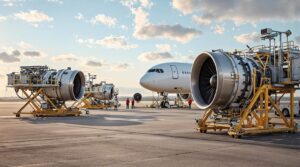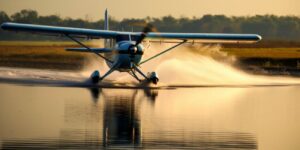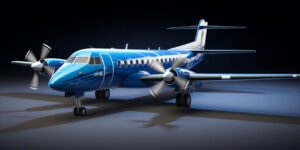Aircraft wings leverage a fundamental principle of physics known as Bernoulli’s principle. As air speeds up over the curved top surface of the wing, it creates an area of low pressure, while the air beneath moves at a slower pace, resulting in higher pressure. This pressure differential generates lift, a force perpendicular to the motion of the airfoil.
However, it’s not solely Bernoulli’s principle at play. Newton’s third law of motion, that for every action there is an equal and opposite reaction, contributes significantly to wing lift. As air is deflected downward by the wing, an upward force is exerted on the aircraft, countering gravity and allowing flight.
The design of aircraft wings varies depending on the aircraft’s purpose. For instance, commercial airliners typically feature wings with a higher aspect ratio, meaning they are longer and narrower, optimizing efficiency during cruising. Contrastingly, fighter jets often adopt shorter, swept-back wings for enhanced maneuverability at high speeds.
Crucially, the shape of the wing’s cross-section, known as the airfoil, significantly influences its performance. Airfoils are meticulously crafted to maximize lift and minimize drag. Engineers meticulously shape the curve and thickness of the airfoil, striving for an ideal balance between lift and drag across various flight conditions.
Furthermore, an aircraft’s ability to control wing lift is vital for safe and controlled flight. Flaps, ailerons, and spoilers are among the mechanisms utilized to modify the wing’s aerodynamic characteristics. Flaps, for instance, can increase both lift and drag during takeoff and landing, aiding in a controlled descent.
Notably, advancements in technology continue to revolutionize aircraft wing design. From morphing wings that adapt to different flight phases to innovative materials enhancing strength and flexibility, these developments aim to improve efficiency, reduce fuel consumption, and enhance overall flight performance.
In essence, the intricacies of how aircraft wings work encompass a delicate interplay of scientific principles, engineering precision, and technological innovation, culminating in the awe-inspiring ability of humans to defy gravity and take flight.
Aerodynamic design and structure of aircraft wings to create lift
Aircraft wings are marvels of engineering, meticulously designed and crafted to harness the principles of aerodynamics and generate the lift necessary for flight. The aerodynamic design of wings involves a careful balance between lift, drag, and stability. Key elements such as airfoil shape, wing span, and wing loading play pivotal roles in determining the overall performance of an aircraft.
The heart of any wing’s lift-generating capability lies in its airfoil shape. Airfoils are carefully sculpted profiles that exploit the Bernoulli’s principle. The upper surface is typically curved, while the lower surface is relatively flat. This asymmetry creates a pressure difference, with lower pressure above the wing and higher pressure below, resulting in lift. Engineers use sophisticated mathematical models and wind tunnel testing to optimize airfoil shapes for specific aircraft and operational requirements.
The wing span is another critical factor influencing lift. A longer wing span provides a larger surface area for air to interact with, thereby increasing lift. However, longer wings can also introduce more drag. Aircraft designers must strike a delicate balance to ensure optimal performance. Variable-sweep wings, which can change their span during flight, offer a compromise, allowing for efficient cruising and improved maneuverability.
Wing loading, defined as the weight supported by a unit area of the wing, is a crucial parameter in determining the aircraft’s flight characteristics. High wing loading results in faster flight speeds and smoother rides at the expense of takeoff and landing performance. Conversely, low wing loading enhances takeoff and landing capabilities but may sacrifice speed. Designers carefully consider the intended use of the aircraft to determine the most suitable wing loading.
The structural composition of aircraft wings is equally vital. Modern wings are typically constructed using lightweight yet sturdy materials such as aluminum alloys, composite materials, or a combination of both. These materials ensure that the wings can withstand the aerodynamic forces encountered during flight while keeping the overall weight of the aircraft within acceptable limits.
Internal wing structure includes spars, ribs, and stringers, forming a skeletal framework that provides strength and shape to the wing. Spars are the primary load-bearing elements running spanwise, while ribs and stringers provide additional support and maintain the wing’s shape. The careful arrangement of these structural components is essential to distribute loads evenly and prevent deformation during flight.
Moreover, advanced technologies such as winglets are employed to enhance the overall efficiency of the wings. Winglets, resembling small fins at the tips of wings, reduce drag by minimizing the wingtip vortices that form during flight. This innovation improves fuel efficiency and contributes to a reduction in environmental impact.
Aircraft wing flaps and slats to control lift and drag
Aircraft wing design is a fascinating interplay of aerodynamics, engineering, and innovation, where various components work harmoniously to ensure optimal performance during flight. Among these crucial elements are wing flaps and slats, high lift devices that play a pivotal role in controlling lift and drag.
Wing flaps are movable surfaces on the trailing edge of an aircraft wing, strategically designed to increase lift and manage descent angles during takeoff and landing. They operate by increasing the wing’s surface area, allowing the aircraft to maintain lift at lower speeds. This ability is particularly critical during the takeoff phase, where sufficient lift is needed to overcome gravity.
Complementing flaps are slats, which are positioned on the leading edge of the wing. Slats are ingenious devices that automatically extend and retract, modifying the wing’s shape to optimize aerodynamic performance. By deploying slats, the wing can generate more lift at lower speeds, enhancing the aircraft’s overall maneuverability and safety during critical phases of flight.
Additionally, aircraft designers employ vortex generators to further refine aerodynamic characteristics. These small, fin-like structures disrupt the smooth airflow over the wing, creating controlled vortices. These vortices energize the boundary layer, enhancing lift and delaying stall conditions. The strategic placement of vortex generators allows for improved control and stability, especially during low-speed flight regimes.
Another innovative concept in aerodynamics is the use of blown flaps, a technology that involves directing high-pressure air from the aircraft’s engines over the wing’s trailing edge. This jet of air energizes the boundary layer, augmenting lift and delaying stall. The precise control afforded by blown flaps enables pilots to achieve optimal performance in various flight conditions.
Factors that influence an aircraft wings ability to produce lift
The aspect ratio of an aircraft’s wings plays a crucial role in determining its efficiency in generating lift. Defined as the ratio of the wingspan to the average chord (width) of the wings, a higher aspect ratio generally leads to lower induced drag and improved lift distribution across the wings. This geometric factor influences the overall aerodynamic performance of an aircraft, impacting both its maneuverability and fuel efficiency.
Another significant factor affecting lift production is wing loading. This parameter is the ratio of the aircraft’s weight to its wing area. A lower wing loading indicates that the aircraft’s weight is distributed over a larger wing area, resulting in reduced stalling speed and better lift capabilities. Conversely, a higher wing loading may lead to higher stalling speeds and compromises in maneuverability.
Induced drag is a critical consideration when assessing an aircraft’s lift generation. Induced drag is the drag created as a consequence of lift production. It is directly affected by the aspect ratio of the wings. Aircraft with higher aspect ratios tend to have lower induced drag, as the longer wingspan allows for more efficient lift distribution, minimizing the drag-inducing vortices at the wingtips.
Considering the interplay of these factors, designers aim to optimize both aspect ratio and wing loading to achieve the desired performance characteristics. An ideal balance is sought, where the wings generate sufficient lift to support the aircraft while minimizing drag to enhance fuel efficiency and overall aerodynamic performance.
In practical terms, a table can be used to illustrate how different aspect ratios and wing loadings impact induced drag. This data can guide engineers in making informed decisions during the aircraft design process. The table might showcase variations in induced drag for different combinations of aspect ratios and wing loadings, providing a visual reference for optimizing these parameters to achieve desired performance outcomes.






